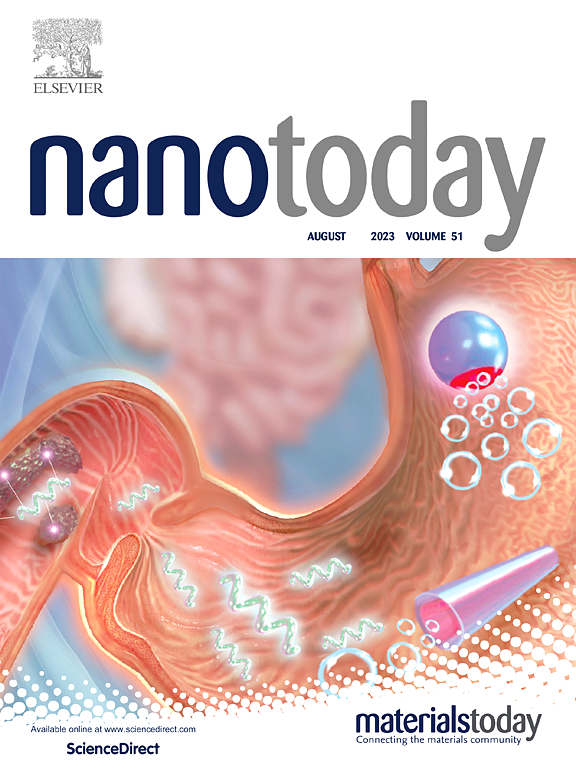Metalamino acid framework (MAF)-mediated macrophage depletion and reprogramming for arthritis treatment
IF 10.9
1区 材料科学
Q1 CHEMISTRY, MULTIDISCIPLINARY
引用次数: 0
Abstract
Inflammatory M1 macrophages play a crucial role in the pathogenesis of rheumatoid arthritis (RA). However, the simultaneous depletion and reprogramming of M1 macrophages in RA therapy remains a significant challenge. To address this issue, we developed a macrophage-targeting metal![]() amino acid framework (MAF) system with dual functions of methotrexate (MTX) delivery and reactive oxygen species (ROS) clearance. Specifically, Zn2 + ions and 9-fluorenylmethyloxycarbonyl-modified histidine (Fmoc-H) form a framework structure (pZFH) through coordination. The Fmoc-His-Thr-Lys-Pro-Arg peptide (Fmoc-HTKPR) can be easily doped into this structure at different ratios to modulate its targeting ability. MTX and Pt nanodots are loaded into the system by incorporating MTX during the pZFH preparation process and reducing platinum salts adsorbed on the surface of the pZFH-MTX nanoparticles (NPs). The targeting peptide enhanced the recognition and uptake of NPs by inflammatory macrophages. The release of MTX in response to the acidic inflammatory environment controls macrophage proliferation, while the Pt nanodots eliminated ROS, thereby promoting the polarization of proinflammatory M1 macrophages towards anti-inflammatory M2 macrophages. In an RA model, pZFH-MTX-Pt significantly reduced the expression of proinflammatory cytokines TNF-α and IL-6, alleviated joint swelling, and decreased bone hyperplasia. This system thus provides a synergistic RA treatment strategy that combines chemotherapy and immunotherapy.
amino acid framework (MAF) system with dual functions of methotrexate (MTX) delivery and reactive oxygen species (ROS) clearance. Specifically, Zn2 + ions and 9-fluorenylmethyloxycarbonyl-modified histidine (Fmoc-H) form a framework structure (pZFH) through coordination. The Fmoc-His-Thr-Lys-Pro-Arg peptide (Fmoc-HTKPR) can be easily doped into this structure at different ratios to modulate its targeting ability. MTX and Pt nanodots are loaded into the system by incorporating MTX during the pZFH preparation process and reducing platinum salts adsorbed on the surface of the pZFH-MTX nanoparticles (NPs). The targeting peptide enhanced the recognition and uptake of NPs by inflammatory macrophages. The release of MTX in response to the acidic inflammatory environment controls macrophage proliferation, while the Pt nanodots eliminated ROS, thereby promoting the polarization of proinflammatory M1 macrophages towards anti-inflammatory M2 macrophages. In an RA model, pZFH-MTX-Pt significantly reduced the expression of proinflammatory cytokines TNF-α and IL-6, alleviated joint swelling, and decreased bone hyperplasia. This system thus provides a synergistic RA treatment strategy that combines chemotherapy and immunotherapy.
元氨基酸框架(MAF)介导的巨噬细胞耗竭和重编程治疗关节炎
炎性M1巨噬细胞在类风湿关节炎(RA)的发病机制中起着至关重要的作用。然而,在RA治疗中M1巨噬细胞的同时耗竭和重编程仍然是一个重大挑战。为了解决这个问题,我们开发了一个巨噬细胞靶向的金属氨基酸框架(MAF)系统,具有甲氨蝶呤(MTX)递送和活性氧(ROS)清除的双重功能。具体来说,Zn2 +离子与9-氟酰甲基羰基修饰组氨酸(Fmoc-H)通过配位形成框架结构(pZFH)。Fmoc-His-Thr-Lys-Pro-Arg肽(Fmoc-HTKPR)可以很容易地以不同的比例掺杂到该结构中,以调节其靶向能力。通过在pZFH制备过程中加入MTX,并还原吸附在pZFH-MTX纳米颗粒(NPs)表面的铂盐,将MTX和Pt纳米点加载到系统中。靶向肽增强了炎性巨噬细胞对NPs的识别和摄取。MTX在酸性炎症环境下的释放控制了巨噬细胞的增殖,而Pt纳米点消除了ROS,从而促进了促炎M1巨噬细胞向抗炎M2巨噬细胞的极化。在RA模型中,pZFH-MTX-Pt可显著降低促炎因子TNF-α和IL-6的表达,减轻关节肿胀,减少骨质增生。因此,该系统提供了一种结合化疗和免疫治疗的协同治疗策略。
本文章由计算机程序翻译,如有差异,请以英文原文为准。
求助全文
约1分钟内获得全文
求助全文
来源期刊

Nano Today
工程技术-材料科学:综合
CiteScore
21.50
自引率
3.40%
发文量
305
审稿时长
40 days
期刊介绍:
Nano Today is a journal dedicated to publishing influential and innovative work in the field of nanoscience and technology. It covers a wide range of subject areas including biomaterials, materials chemistry, materials science, chemistry, bioengineering, biochemistry, genetics and molecular biology, engineering, and nanotechnology. The journal considers articles that inform readers about the latest research, breakthroughs, and topical issues in these fields. It provides comprehensive coverage through a mixture of peer-reviewed articles, research news, and information on key developments. Nano Today is abstracted and indexed in Science Citation Index, Ei Compendex, Embase, Scopus, and INSPEC.
 求助内容:
求助内容: 应助结果提醒方式:
应助结果提醒方式:


